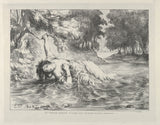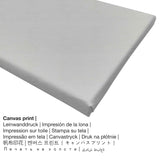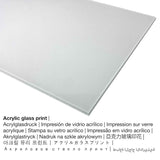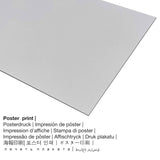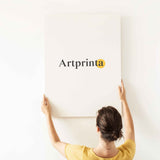Eugène Delacroix, 1843 - La mort d'Ophélie - tirage d'art
TTC Expédition calculée à la caisse.
The Death of Ophelia était par le peintre Eugène Delacroix dans l'année 1843. La version de l'œuvre d'art a la taille suivante: Image : 9 15/16 x 7 1/4 po (25,3 x 18,4 cm) Feuille : 11 x 8 9/16 po (28 x 21,8 cm). Lithograph; second state of four was applied by the European artist as the medium of the work of art. This work of art is included in the digital collection of The Metropolitan Museum of Art. With courtesy of Le Metropolitan Museum of Art, New York, Rogers Fund, 1922 (sous licence - domaine public). : Rogers Fund, 1922. Besides this, the alignment of the digital reproduction is in paysage format avec un rapport d'image de 4: 3, meaning that the length is 33% longer than the width. The painter Eugène Delacroix was an artist from France, whose artistic style was mainly Romanticism. The French artist was born in the year 1798 à Saint-Maurice, Val-de-Marne et est décédé à l'âge de 65 en 1863 à Paris.
Vos options de matériaux de produit
The product dropdown menu gives you the opportunity to select your favorite material and size. Pick your favorite size and material among the following options:
- L'impression d'affiche (matériel de toile): A poster is a printed canvas paper with a granular texture on the surface. It is particularly suited for putting the fine art print with a custom-made frame. Please keep in mind, that depending on the absolute size of the poster we add a white margin of something between 2-6cm around the painting, which facilitates the framing with your custom frame.
- Impression sur verre acrylique brillant: A glossy print on acrylic glass, which is often referenced as a plexiglass print, transforms an original into amazing décor. The artwork is being made with state-of-the-art UV direct print technology. This has the impression of rich, sharp colors.
- Métal (impression dibond en aluminium): Aluminium Dibond prints are metal prints with an outstanding effect of depth. For the Direct Print On Aluminum Dibond, we print the selected work of art onto the surface of the white-primed aluminum material. The white & bright sections of the original artpiece shine with a silk gloss, however without glare. The colors are bright and luminous, fine details of the print appear crisp, and the print has a a matte appearance you can literally feel.
- L'impression sur toile: A printed canvas material mounted on a wood frame. Your printed canvas of your favorite masterpiece will let you turn your into a large artwork. The great advantage of canvas prints is that they are relatively low in weight, which implies that it is easy and straightforward to hang up your Canvas print without the help of any wall-mounts. A canvas print is suited for any type of wall.
Informations importantes: We strive in order to describe our products as closely as possible and to exhibit them visually. Nonetheless, the pigments of the printed materials and the printing can vary to a certain extent from the presentation on the device's screen. Depending on the settings of your screen and the condition of the surface, color pigments may not be printed one hundret percent realistically. Given that our art prints are processed and printed by hand, there might also be slight differences in the motif's exact position and the size.
A propos de ce produit
| Type de produit d'impression: | tirage d'art |
| Méthode de reproduction: | reproduction au format numérique |
| Processus de fabrication: | impression numérique |
| Provenance: | fabriqué en Allemagne |
| Type de stock: | production à la demande |
| Utilisation prévue: | mur de la galerie, galerie de reproduction d'art |
| Alignement: | format paysage |
| Rapport d'aspect de l'image: | 4: 3 longueur Largeur |
| Implication: | la longueur est 33% plus longue que la largeur |
| Matériaux au choix: | impression d'affiche (papier de toile), impression sur verre acrylique (avec revêtement en verre véritable), impression en métal (aluminium dibond), impression sur toile |
| Options de taille d'impression sur toile (toile sur châssis de civière): | 40x30cm - 16x12 ", 80x60cm - 31x24", 120x90cm - 47x35 ", 160x120cm - 63x47" |
| Options d'impression sur verre acrylique (avec revêtement en verre véritable): | 40x30cm - 16x12 ", 80x60cm - 31x24", 120x90cm - 47x35 " |
| Variantes de taille d'impression d'affiche (papier de toile): | 40x30cm - 16x12 ", 80x60cm - 31x24", 120x90cm - 47x35 " |
| Options d'impression en aluminium: | 40x30cm - 16x12 ", 80x60cm - 31x24", 120x90cm - 47x35 " |
| Cadre: | produit sans cadre |
Spécifications de l'œuvre d'art
| Nom de l'oeuvre: | "The Death of Ophelia" |
| Catégorisation de l'œuvre d'art: | peinture |
| Catégorie générale: | l'art moderne |
| siècle: | 19th siècle |
| Créé dans l'année: | 1843 |
| Âge de l'oeuvre: | 170 ans |
| Support d'illustration originale: | lithograph; second state of four |
| Dimensions de l'oeuvre originale: | Image : 9 15/16 x 7 1/4 po (25,3 x 18,4 cm) Feuille : 11 x 8 9/16 po (28 x 21,8 cm) |
| Musée: | Le Metropolitan Museum of Art |
| Emplacement du musée: | New York City, New York, États-Unis d'Amérique |
| Site Web : | www.metmuseum.org |
| Type de licence d'illustration: | domaine public |
| Avec l'aimable autorisation de: | Le Metropolitan Museum of Art, New York, Rogers Fund, 1922 |
| Ligne de crédit de l'oeuvre: | Fonds Rogers, 1922 |
Table d'artiste
| Nom d'artiste: | Eugène Delacroix |
| Genre: | mâle |
| Nationalité de l'artiste: | Français |
| Professions de l'artiste: | peintre |
| Pays : | France |
| Classification: | artiste moderne |
| Styles d'art: | le romantisme |
| Vie: | 65 ans |
| Année de naissance: | 1798 |
| Lieu de naissance: | Saint-Maurice, Val-de-Marne |
| Année de décès: | 1863 |
| Décédé à (lieu): | Paris |
© Copyright - propriété intellectuelle de | Artprinta.com
Description supplémentaire du Metropolitan Museum of Art (© - par le Metropolitan Museum of Art - www.metmuseum.org)
En 1834, Delacroix commença une série de lithographies consacrées à Hamlet, créant des images maussades qui reflètent la psyché troublée du prince. Choisissant des scènes clés et des passages poétiques, les images très personnelles et dramatiques de l'artiste étaient inhabituelles en France, où l'intérêt pour Shakespeare ne s'est développé qu'au XIXe siècle. Ici, Ophélie, dont l'esprit est devenu déséquilibré par le meurtre de son père Polonius et le rejet d'Hamlet, est tombée dans un ruisseau alors qu'elle cueillait des fleurs, et sa robe gorgée d'eau l'entraînera bientôt vers la « mort boueuse ». Ce triste événement se déroule en coulisses et est poétiquement décrit dans l'acte 4, scène 7 par la reine Gertrude. Gihaut frères a publié l'ensemble de treize tirages de l'artiste en 1843, avec une deuxième édition augmentée de seize publiée par Bertauts en 1864. Cooly reçut dans un premier temps, les tirages furent finalement reconnus comme l'une des réalisations les plus significatives de l'artiste.

